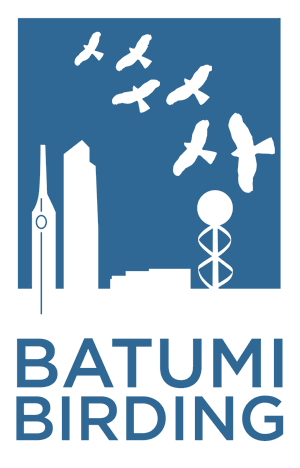The hilltop of Sakhalvasho has been Batumi Raptor Count’s first count station since 2008. Its strategic location as the highest point in the landscape has also attracted military attention, and in 2011 the site was chosen for the construction of a top secret base. With the change of government, this plan was abandoned though, and the now flattened hilltop continues to serve as an excellent watchpoint. Facilities on the watchpoint are basic, but include a toilet and shelter. Keep in mind that the sun can burn fiercely, while thunderstorms are frequent and can be dangerous.
Throughout autumn, the migration here will never fail to impress. In late August, the Honey Buzzard season starts, and most years see one or two 100,000+ days. Early in the season it pays off to arrive around sunrise, when hundreds or thousands of Harriers (mostly Montagu’s and Marsh) pass through. From the second week of September onwards, the migration becomes more diverse, with more and more Black Kites and Booted Eagles joining the flocks, and Levant Sparrowhawk and Pallid Harrier adding spice to the mix. Very enjoyable are also the Bee-eaters, with thousands and thousands passing through and filling the sky with their purring sounds. You may be lucky to pick up a blue-cheeked, although this has proven easier in the nearby Chorokhi delta. And then there are the rollers, displaying their coulourful wings when flying over the count station in small flocks. Mid of September is the best time to see one of Batumi’s main highlights: the Crested Honey-buzzard. This rare migrant from east Siberia passes through Batumi in small numbers, and with some luck and the assistance of skilled BRC counters, you may be able to pick one out of the never-ending streams.
Juvenile Saker Falcon. Photo by John Wright.
Later September brings a very different migration. There are still some Honey Buzzards around, mostly juveniles, and Black Kite and Booted Eagle are still numerous. But the bulk of the migration is now made up of Steppe Buzzards and Eagles. At this time of the year, it is recommended to spend some time on the Shuamta station, which is better for those species with a more eastern migration route, but Sakhalvasho also has some specialties. Red-footed Falcon is almost exclusively seen here. Its numbers are highly unpredictable and very weather dependent, but in some years several thousands have come through on a single day.
Short-toed Eagle. Photo by Alan Dalton.
A particularly nice aspect of the watch point is its social side. Here you will meet birders from all over Europe, and the raptor counters of the BRC, who are extremely skilled at picking up the elusive crested honey buzzard or determining the age and sex of an eagle. The raptor count has been taking place for almost a decennium now, and has much increased our insight in the eastern Black Sea flyway.
Behind this watchpoint you will find the start of the Batumi Raptor Trail. This path was constructed in 2014 with the aid of the European Outdoor Conservation Association (EOCA). With a length of ca. 3km, it takes you eastwards along the ridge. Here, raptors can often be observed from close by as they struggle to pass the ridge. Unfortunately, many hunters come here to shoot raptors, and the raptor trail aims to involve local communities in an attempt to raise awareness about migratory birds. It is also used extensively for educational activities in cooperation with local schools.

